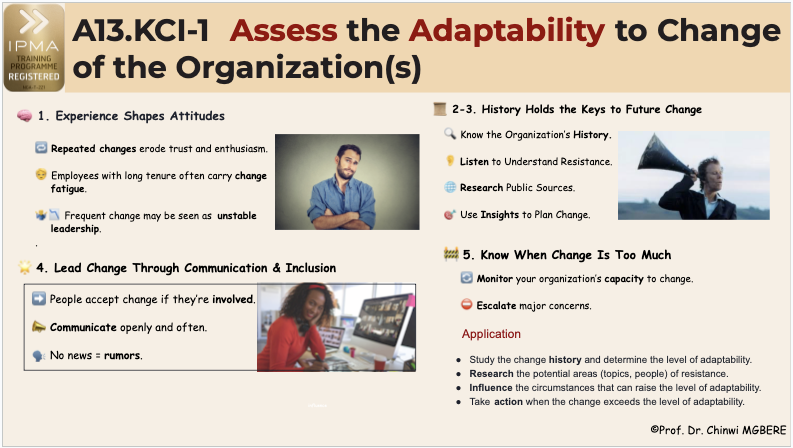

LESSON 1: ASSESS THE ADAPTABILITY TO CHANGE OF THE ORGANISATION(S)
CPD: 2 hours

1. Organizational Readiness for Change
The extent to which people in an organization are prepared for change is largely influenced by their previous experiences with change processes. If employees have faced multiple reorganizations over the years, their perception of a new change will differ significantly from their first experience. Understandably, many become skeptical. This skepticism isn't surprising—when changes occur frequently, it may signal to staff that leadership lacks a clear direction. One employee once jokingly asked, “Which reorganization do you work for?”—a reflection of the confusion and fatigue that can set in over time.
2. Understanding the Organization’s History
When managing a project or programme that involves organizational change—especially as an external manager—it is crucial to understand the organization's history. Since you haven’t lived through it yourself, you need to examine past changes in detail. The organization’s adaptability, shaped by its experiences, sets the boundaries of what can reasonably be expected from employees. A strong understanding of this history enables more accurate judgments about the pace and scale of change the organization can handle.
3. Listening and Researching to Identify Resistance
To uncover where resistance lies—and how deeply rooted it is—you must listen to employees. Their insights are invaluable. In addition, researching past reorganizations through publicly available sources such as news articles or online content can be enlightening. Media coverage can reveal how staff have reacted to past changes and help you anticipate potential reactions, allowing you to proactively address concerns and manage resistance more effectively.
4. Communication and Employee Involvement
In general, people are open to change—provided they feel involved in the process. Resistance often arises when people feel they are being forced to change without their input. To reduce this resistance, involve employees in shaping their own future. Frequent and transparent communication is key. Even if all the details aren’t clear yet, it’s better to acknowledge this honestly than to stay silent. A lack of information breeds uncertainty—and in that vacuum, rumors and speculation thrive, wasting time and eroding trust.
5. Recognizing Limits and Escalating Concerns
If you assess that a planned change exceeds the organization’s current capacity to adapt, it’s important to act. Resistance rooted in powerlessness or change fatigue presents a serious risk. When resistance becomes insurmountable due to these limitations, it must be treated as a critical constraint. In such cases, it is essential to escalate the issue to senior leadership and ensure they are fully aware of the implications.
Application
You can convert the above into actions on the project/programme/portfolio for which you are currently responsible, by carrying out the following steps:
Study the change history and determine the level of adaptability.
Research the potential areas of resistance.
Influence the circumstances that can raise the level of adaptability.
Take action when the change exceeds the level of adaptability.